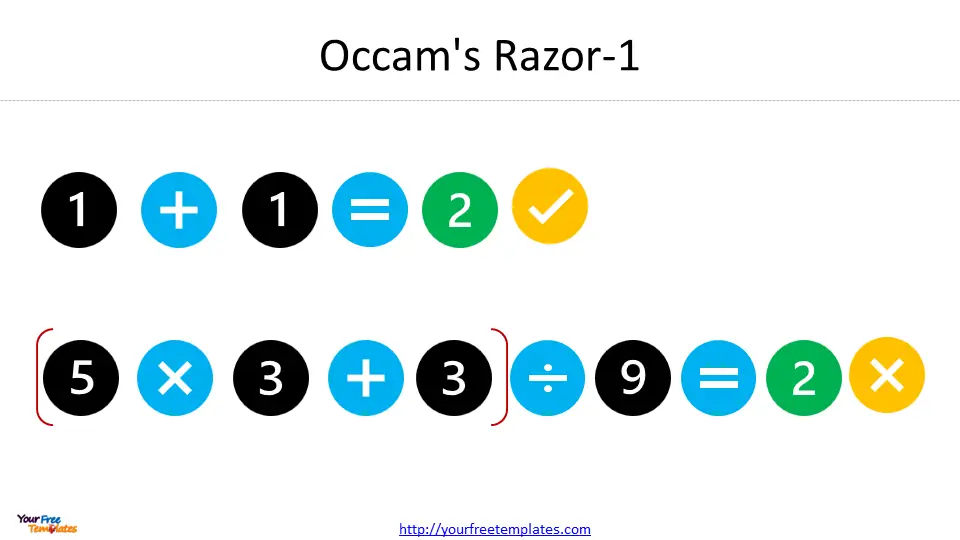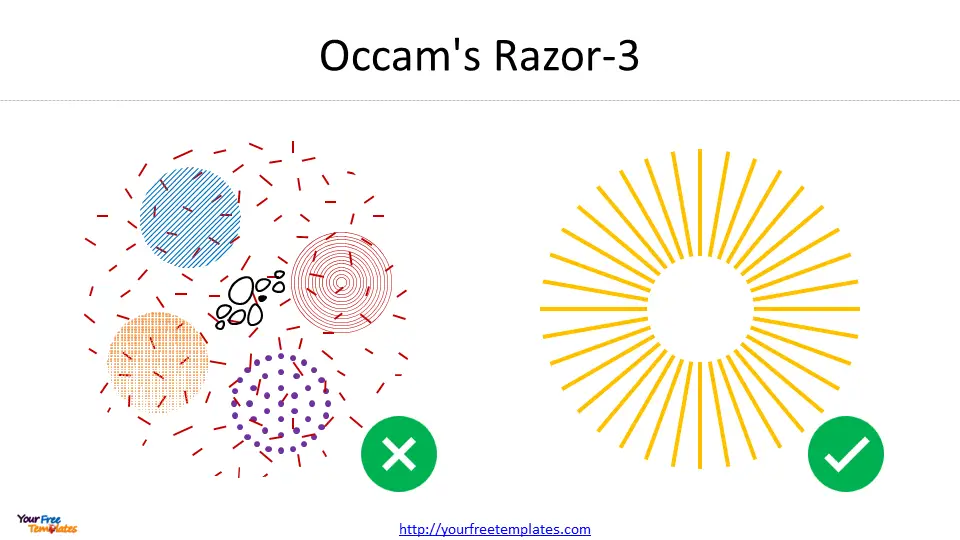In the realm of reasoning and problem-solving, Occam’s razor serves as a beacon, guiding thinkers toward simplicity over complexity. This principle, which advocates for the simplest explanation being preferable when faced with competing hypotheses, has permeated various disciplines, from science to philosophy. Its application underscores the elegance of parsimony, suggesting that entities should not be multiplied beyond necessity. The significance of Occam’s razor lies not just in its methodological approach but also in its philosophical implications, emphasizing that simplicity is often closer to the truth.
At the end of this post, you can download our Occam’s Razor PowerPoint template to fit your purpose. As the same diagram PowerPoint template series, you can also find our Data Mining, marketing segment, Porter’s five forces, SWOT Analysis, GE Matrix, BCG Matrix, Artificial Intelligence, National Diamond and BlockChain PowerPoint templates.
This article delves into the essence of Occam’s razor, exploring its historical roots and evolution over time. It outlines the principle’s application across different fields, demonstrating its widespread influence and utility. Furthermore, the piece examines criticisms and limitations, addressing the debate over its efficacy and scope. Concluding with a synthesis of Occam’s razor’s relevance in contemporary discourse, the discussion aims to provide a comprehensive overview of this enduring principle. Through this examination, readers will gain insight into why Occam’s razor, also referenced in variations as occams razor, akmans razor, and ocrams razor, continues to be a foundational tool in critical thinking and analytical decision-making.

What is Occam’s Razor?
Occam’s Razor, a principle attributed to the 14th-century friar William of Ockham, posits that when faced with competing explanations for the same phenomenon, the simpler one is preferable 1. This concept has been echoed by notable figures such as Albert Einstein and Isaac Newton, who emphasized simplicity in explaining natural phenomena 1.
The principle, articulated by the Scholastic philosopher William of Ockham, is formally stated as “pluralitas non est ponenda sine necessitate,” which translates to “plurality should not be posited without necessity” 2. This guideline advocates for simplicity, suggesting that among competing theories, the one with fewer assumptions should be selected 3.
Occam’s Razor is not just a theoretical construct but applies practically across various fields. For instance, in software development, a program with fewer lines of code is generally preferred as it is less prone to errors 1. Similarly, in medicine, simpler diagnoses are considered first before exploring more complex conditions 1.
It is crucial to understand that Occam’s Razor serves as a logical guideline rather than a strict rule. It does not promote oversimplification but rather supports choosing explanations that adequately account for all observed phenomena without unnecessary complexities 1. In cases where a more intricate theory provides a better explanation, it should be preferred 1.
This principle is also known as the law of parsimony or lex parsimoniae, emphasizing that explanations should employ the smallest necessary number of assumptions 3. While Occam never explicitly stated “Entities must not be multiplied beyond necessity,” this phrase effectively captures the essence of his approach 3.
In summary, Occam’s Razor remains a fundamental heuristic in scientific inquiry, promoting simplicity in explanations and decision-making processes across diverse disciplines.
Historical Background
Early Formulations
The concept of simplicity in theoretical frameworks has been esteemed across various epochs, starting from ancient philosophers to medieval theologians. Aristotle, in his “Posterior Analytics,” posited that demonstrations derived from fewer postulates are superior 3. This notion was echoed by St. Thomas Aquinas, who believed that nature does not employ two instruments where one suffices, emphasizing the efficiency of simplicity 3. The principle of not multiplying entities unnecessarily was also supported by Galileo and Newton, who both advocated for the simplest hypotheses in explaining natural phenomena 3.
William of Ockham
William of Ockham, a pivotal figure in the formulation of the principle now known as Occam’s Razor, was born around 1287 in Ockham, Surrey 2. He was a proponent of nominalism and argued against the real existence of universals outside of the mind 2. Ockham’s advocacy for methodological and content reform in scholasticism aimed at simplification, which he believed would lead to a clearer understanding of theology and science 2. His famous dictum, “Entities must not be multiplied beyond necessity,” although not found in these exact words in his works, encapsulates the essence of his philosophical approach 2.
Later Philosophical Developments
The principle of simplicity continued to influence various scholars and scientists beyond the medieval period. Immanuel Kant, in his “Critique of Pure Reason,” reiterated the need to avoid unnecessary multiplications of entities and principles 3. This approach was not confined to philosophy alone; it permeated scientific thinking as well. Lavoisier, in the 18th century, dismissed the phlogiston theory in chemistry by applying Occam’s Razor, advocating for explanations that do not assume unobservable entities 3. The principle’s utility has been acknowledged in modern times as well, with surveys indicating that Nobel laureates in economics consider simplicity a desirable feature in economic theories 3.

Applications of Occam’s Razor
In Science
Occam’s Razor serves as a guiding heuristic in the development of scientific theories and models. In physics, it played a crucial role in Albert Einstein’s formulation of special relativity and in the foundational work of quantum mechanics by pioneers like Max Planck and Werner Heisenberg . Similarly, in chemistry, it aids in formulating reaction mechanisms, although its effectiveness as a criterion for choosing between existing models can be limited 4. The principle asserts that the simplest explanation consistent with the data is preferred, yet acknowledges that this preference may shift as new evidence emerges 5.
In Medicine
The principle of diagnostic parsimony in medicine typically favors a single, comprehensive diagnosis over multiple, fragmented ones, especially when both explanations account equally well for the observed symptoms 6. However, the application of Occam’s Razor in medicine must be approached with caution. In cases of polymorbidity, where patients present with multiple comorbid conditions, the simplest diagnostic conclusion may overlook critical aspects, leading potentially to misdiagnoses and under-treatment of complex cases 7.
In Everyday Decision-Making
Occam’s Razor is not only a scientific and medical tool but also a principle that laypersons apply in daily problem-solving scenarios. From diagnosing car troubles to interpreting social interactions, the preference for the simplest explanation often provides a practical and time-efficient solution 8. However, it’s important to remember that while Occam’s Razor favors simplicity, more complex explanations might occasionally prove more accurate. This balance between simplicity and complexity is a testament to the principle’s pragmatic utility in everyday life 8.
Criticisms and Limitations
Misinterpretation
Occam’s Razor is frequently misunderstood as advocating for the simplest explanation in all circumstances. Critics argue that this misinterpretation can lead to an oversimplification that overlooks necessary complexities and context in certain scenarios. For instance, the principle is sometimes misapplied by prematurely favoring an explanation that appears straightforward without adequate investigation, potentially dismissing more accurate explanations that require more detailed consideration 910. This misuse highlights the risk of relying too heavily on simplicity, especially in complex fields where multiple factors must be considered.
Exceptions to the Rule
While Occam’s Razor serves as a useful heuristic, there are notable exceptions where its application can be inappropriate or misleading. In scientific practice, the simplest hypothesis is not always the most likely to be correct. For example, the introduction of additional variables or entities might become necessary when simpler models fail to adequately explain observations or predict phenomena 1112. Furthermore, the principle’s emphasis on simplicity can be counterproductive in cases where a more complex theory provides better explanatory power and predictive accuracy, challenging the notion that simpler is inherently superior 1112.
In summary, while Occam’s Razor is a valuable tool in various disciplines, its application must be tempered with a critical understanding of its limitations and the context in which it is being applied.

Conclusion
Throughout the discourse on Occam’s Razor, we’ve navigated its historical evolution, theoretical framework, and diverse applications, illustrating its profound influence across fields as varied as science, medicine, and everyday decision-making. We’ve seen how this principle of simplicity, while not universally definitive, serves as a vital heuristic, guiding the quest for explanations that are both parsimonious and congruent with observed phenomena. Its enduring relevance and utility underscore the principle’s value in fostering clear, efficient, and effective reasoning, reminding us of the power inherent in seeking simplicity amidst complexity.
However, as we’ve also explored, the application of Occam’s Razor is not without its criticisms and limitations, necessitating a balanced approach that considers the nuances of each unique situation. By acknowledging instances where simplicity may yield to complexity for a more accurate or comprehensive explanation, we allow for a more thoughtful application of this heuristic. In doing so, we pave the way for further inquiry and exploration, encouraging a critical examination of when and how to employ Occam’s Razor, not as an inflexible rule but as a guiding principle in the perpetual quest for understanding.
FAQs
1. What is a straightforward definition of Occam’s Razor?
Occam’s Razor, a principle attributed to the 14th-century friar William of Ockham, suggests that when faced with competing explanations for the same phenomenon, the simpler one is preferable.
2. What does the principle of simplicity entail?
In psychology and cognitive science, the principle of simplicity suggests that the human mind tends to interpret the world through the simplest mental models or representations possible, showing a preference for simplicity.
3. How does Occam’s Razor advocate for simplicity?
Occam’s Razor, established in the 14th Century, is a problem-solving principle advocating that simplicity should be preferred over complexity. This principle is applicable in various fields, including detective work and deductive reasoning about the cosmos.
4. What does Occam’s Razor imply about the simplest solutions?
Occam’s Razor, also known as the law of parsimony, posits that it is unnecessary to use more when less will suffice. This suggests that the simplest explanation is often the most likely to be correct.
Need premium maps, pls visit our map shop: https://editablemaps.com
Size:282K
Type: PPTX
Occam’s Razor Template
Click the link to download it.
Aspect Ratio: Standard 4:3
Click the blue button to download it.
Download the 4:3 Template
Aspect Ratio: Widescreen 16:9
Click the green button to download it.
Download the 16:9 Template
References
[1] – https://www.newscientist.com/definition/occams-razor/
[2] – https://www.britannica.com/topic/Occams-razor
[3] – https://en.wikipedia.org/wiki/Occam%27s_razor
[4] – https://fs.blog/occams-razor/
[5] – https://conceptually.org/concepts/occams-razor
[6] – https://www.amjmed.com/article/S0002-9343(20)30801-9/fulltext
[7] – https://www.wolterskluwer.com/en/expert-insights/how-to-diagnose-a-rare-disease-when-occams-razor-fails
[8] – https://www.quora.com/What-are-some-good-examples-to-explain-Occams-Razor
[9] – https://www.quora.com/What-are-some-examples-of-where-Occams-Razor-does-not-apply-or-exceptions-to-it-can-be-found
[10] – https://www.quora.com/What-is-the-most-misunderstood-thing-about-Occams-razor
[11] – https://philosophy.stackexchange.com/questions/77943/limitations-to-occams-razor
[12] – https://science.thewire.in/the-sciences/ockham-razor-deeply-misleading/














